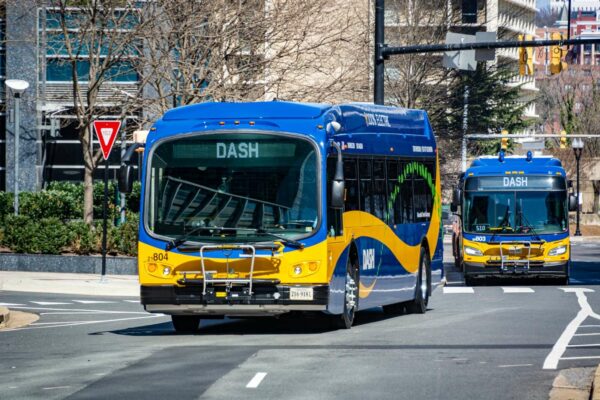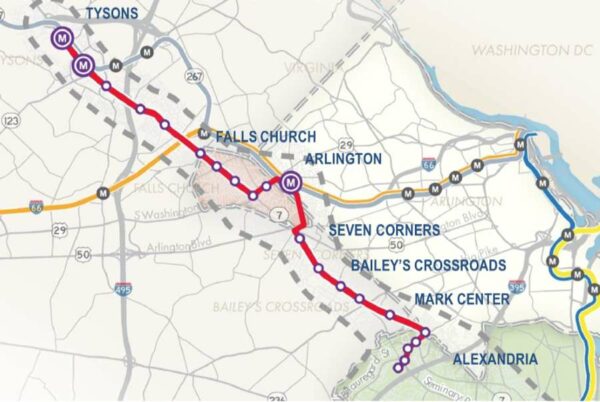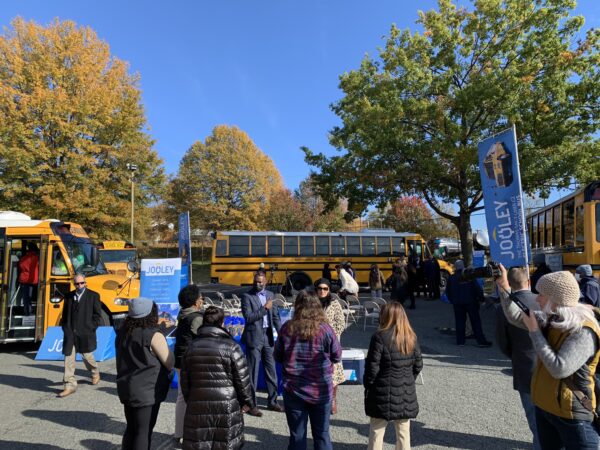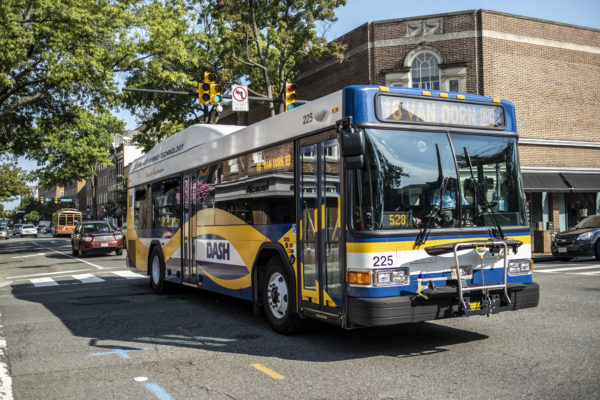
The Alexandria bus system has seen a significant uptick in ridership over the last few months, thanks in part to the new fare-free policy, changes to the DASH network and declining Covid numbers.
DASH said ridership hit nearly 300,000 total boardings in March, a 73% increase over ridership in August before the change to the new network. Ridership dipped significantly in January during the Omicron variant.
“In the first four months after the new network launch in September 2021, DASH saw a 50% increase in monthly boardings, which was the largest four-month ridership surge in over a decade,” the bus system said in a release. “After briefly receding in January and February due to the Omicron variant, ridership spiked again in March with a nearly 46% increase over February. DASH has now achieved 95% of pre-COVID ridership levels. The 73% increase from August 2021 to March 2022 marks the largest ridership increase over a seven-month span in recent DASH history.”
DASH said the largest ridership increases have been middays and weekends, in part due to the changes to the bus schedule. The new schedule provides more off-peak service in the West End, Arlandria and along King Street. The release also noted that higher gas prices may have been a windfall for bus ridership.
The city announced plans to make DASH fare free last April and the change went into effect in September. The city has pursued state funding to help make the change long-term.
“We are absolutely thrilled to see that the Alexandria community is embracing the first phase of our long-term Alexandria Transit Vision (ATV) Plan,” said DASH General Manager/CEO Josh Baker in the release. “Our shared goal with the City of Alexandria in implementing the ATV Plan is to provide more useful bus service that makes transit a more relevant option for more trips in Alexandria. As we continue to get more people on the bus, the entire Alexandria community benefits from less traffic congestion, reduced parking demand, reduced climate impact, and a better overall quality of life.”
Photo via DASH/Facebook

The Northern Virginia Transportation Commission (NVTC) is starting to look at financing for an extensive transportation project connecting Alexandria and Tysons.
The Envision Route 7 BRT project aims to bring a high-capacity transit service running from Tysons to Mark center in Alexandria, with stops at Seven Corners, Falls Church and the East Falls Church Metro station. The project is currently undergoing a mobility study looking over traffic operations and impact, with a particular eye toward the Falls Church segment.
At a meeting scheduled for Thursday, March 3, the is scheduled to look over next steps for the Envision Route 7 BRT project. A report to the NVTC laid out a timeline ahead for the project. Traffic modeling and simulation is planned to continue through the summer with public meetings and outreach for the project starting this fall.

NVTC staff are also working on identifying key funding, governance and operational decisions ahead for the project, the report said.
The effort is proposed to be jointly funded by Fairfax County and NVTC and will focus on the following elements:
- Develop a strategic framework that will serve as a guide for NVTC staff and the
Commission in the implementation of the BRT project.- Identify and prioritize the key funding sources for each stage of the BRT project and the
applicable timeline for each funding source.- Develop an interjurisdictional governance approach to guide the planning,
implementation, and operation of the BRT project.
The report said that proposals for consulting on the project are likely to come back to the NVTC at the meeting in May.
Alexandria’s DASH bus service is headed back to regular service after the omicron surge of COVID-19 forced the bus system to operate with a reduced schedule.
DASH scaled back its weekday bus service in December, with many lines operating on the reduced weekend hours and frequency.
“All DASH buses will resume regular weekday service beginning Monday, Feb. 28,” the service said in a press release. “The Alexandria Transit Company, which operates the DASH bus system, temporarily adjusted service schedules in January due to COVID-19 related staffing shortages.”
While DASH has recovered enough to resume normal service, the release did say that DASH continues to face a shortage of transit workers and bus operators and will continue monitoring ridership and staffing to make changes as needed.
Despite the omicron-related hurdle, DASH ridership has gradually been climbing back to pre-pandemic levels.
“We are excited to resume regular weekday service because it provides greater bus frequency to Alexandria,” said DASH General Manager/CEO Josh Baker. “Thank you to our riders and our community for weathering these challenges with us.”

If the city wants a fully electrical bus fleet, DASH leadership said its going to need to invest in making sure buses can recharge across the city.
In a meeting with the City Council ahead of the legislative session last night, DASH General Manager Josh Baker outlined some challenges facing the city as it pushes to have a fully electric bus fleet by 2035.
The city is already laying the groundwork for some of the infrastructure needs. DASH is currently undergoing an expansion that will add a new electric bus lot. There are other areas, though, where Baker said the city’s needs are outpacing technological limits.
“The technology is very new so we’re very much a pioneer on the implementation of this,” Baker said.
Some of the challenges to the electric bus fleet were already noted in earlier reports. Cold weather, for instance, can cause the batteries to drain more quickly because power is being redirected to heat. Other reports noted that electric buses can sometimes struggle with hills.
One of the larger issues, Baker said, is that electric buses will need to charge while traveling the city in-service rather than needing to come back to DASH headquarters.
“We need to see the technology continue to catch up to address charging infrastructure and we’re looking for ways to have equipment that can charge buses en route rather than bring them back to the facility, charge for several hours, and sent back out on service,” Baker said. “That’s what we need to figure out to have a fully electric fleet that’s sustainable.”
Baker also said that cost is currently an issue, with electric buses costing nearly twice as much as standard diesel buses.
“An electric bus costs several hundred thousand dollars more per unit than a standard diesel bus counterpart,” Baker said. “[It’s] $575,000 for a diesel and around $900,000 for electric.”
But Baker said as there’s more production and nationwide implementation of electric buses, that could change.
“Those numbers are coming down and we believe implementation across the country will help that, but it is early on,” Baker said. “We need to see the technology catch up.”
Photo via DASH/Facebook

DASH ridership has been working its way back up toward pre-pandemic levels after a nasty slump caused by COVID-19.
In a monthly newsletter, Alexandria Mayor Justin Wilson shared some figures for DASH ridership from the months after the city’s new fare-free program and route adjustment was put into place.
- In October, DASH experienced 256,000 systemwide boardings. This was the highest single month since February of 2020.
- Total DASH ridership increased by 50% between August and October.
- Our October ridership represents about 72% of pre-pandemic ridership.
- West End ridership presently exceeds pre-pandemic volume.
The bus service has hit a few bumps recently. DASH services have also been temporarily scaled back due to a bus operator shortage caused by the widespread omicron variant of COVID-19. Separately, DASH is also working on implementing electric buses, but has found that the buses have difficulty with uneven terrain and have unreliable chargers.
The city is also seeking state funding to make the fare-free program long-term.
“This is an important step forward as we create a transit system that serves more of our community with more efficient and relevant service,” Wilson said. “So far, it looks like it’s working.”
Photo via DASH/Facebook
One day after a severe snowstorm hit Alexandria, some things are returning to normal while other services remain closed.
Alexandria bus service DASH suspended service yesterday, but has since returned with snow routes — adjusted routes following more thoroughly cleared sections of roadway.
https://twitter.com/DASHBus/status/1478381102976978948
City facilities had a delayed reopening at 10 a.m. today with local courts remaining closed. Alexandria libraries scheduled to open at 10 a.m. will instead be opening at noon to give staff time to clear off the sidewalks. The Animal Welfare League of Alexandria is open by-appointment starting at noon.
The AWLA will open BY APPOINTMENT today at noon. If you have any wildlife concerns or animal emergencies, please call 703.746.4444. Thank you! pic.twitter.com/C6C3kskjsA
— AWLA Alexandria (@AlexAnimals) January 4, 2022
Alexandria City Public Schools has moved to virtual schooling for the second day in a row.
Those who set their trash, recycling, yard waste or leaf collection out today may have already discovered this, but the Monday collection has slid to Wednesday, Jan. 5., with every day offset by two after that.
Meanwhile, the city said in a press release that road and sidewalk clearing is still underway and property owners should be clearing sidewalks.
“Roads are plowed by priority,” the city said. “Snow emergency routes are plowed first, followed by secondary routes, intermediate routes, and then residential streets… Clearing sidewalks, driveways, and entrances is the responsibility of the adjacent property owner, occupant, community association, or business. The recent storm event has been declared Level 2. As a result, responsible parties have 48 hours from the end of snowfall at 2 p.m. on Monday, January 3 to clear paths. The deadline for clearing paths and walkways is Wednesday, January 5, at 2 p.m.”

Electric buses have had a big boost this past month in Alexandria, with DASH laying out future plans for its all-electric fleet and Alexandria City Public Schools (ACPS) welcomed five new electric buses to the school’s fleet.
But electric buses have also faced some technological hurdles as well. DASH leadership noted that the buses struggle with hills and highways, and they also lack some of the heating of traditional diesel buses where the heat is supplied by the output from the engine.
DASH reported that the new electric buses have been less expensive in maintenance and operational costs than the older diesel buses — a claim ACPS echoed earlier this week — but also said the recharging ports have had a tendency to become suddenly non-functional and it can be difficult to get contractors out to have them fixed in a timely manner. Perhaps most importantly, electric buses are a significant environmental improvement over diesel buses.
Overall, DASH is hoping to have a fully-electric bus fleet by 2025 with all diesel hybrids phased out by 2027.
Photo via DASH/Facebook

Alexandria’s bus service DASH isn’t alone in starting its electric conversion; yesterday Alexandria City Public Schools celebrated the addition of five new electric buses to the school system’s bus fleet.
At an event yesterday, ACPS and Dominion Energy leadership celebrated the launch of the new buses.
“In a unique public-private partnership, the Dominion Energy program provided the batteries and charging stations needed to operate the five buses that ACPS purchased for the same price as diesel models,” ACPS said in a press release. “The electric school buses are part of ACPS’ commitment to sustainability and hybrid vehicles. The new buses operate entirely by electrical power, help store electricity and stabilize the power grid while creating a quieter ride for students.”
https://twitter.com/tchrnme29824/status/1460791509201137667
The schools’ shift toward electricity comes as the citywide bus service DASH also is moving toward having a full-electric fleet, though DASH leadership said the buses have encountered some issues with heating and hills.
Like DASH, though, ACPS said the electric buses come with an economic benefit to the city — costing 60% less to maintain and operate compared to diesel buses.
The ACPS event was also one of the increasingly few celebrations where Dominion was welcomed with open arms in Alexandria. The energy company has been in hot water with the City of Alexandria after a series of catastrophic power failures one year after Dominion representatives told city leadership that earlier power failures weren’t emblematic of larger problems.
Photo via Abdel Elnoubi/Twitter

Alexandria bus network DASH has been charging ahead on its electric bus program, but DASH leadership said the initiative has also faced a few bumps in the road.
At a meeting of the Northern Virginia Transportation Commission last week, DASH General Manager Josh Baker shared some of the city bus service’s experience with implementing electrical buses.
“At DASH, we are endeavoring to have a fully zero-emissions fleet by 2025 with phase-out of diesel and hybrid buses by 2027,” Baker said. “The 2025 benchmark is to understand that buses have a minimum 12-year duty cycle.”
While Baker said that electric buses are a big short-term investment — approximately $5.1 million for six battery-electric transit buses and fast chargers — the idea is that electric buses will counter-balance that with long-term benefits to maintenance and fuel costs. So far, Baker said that’s been borne out by electric buses requiring half maintenance cost compared to diesel counterparts, though it’s worth noting that the electric buses are also newer than the diesel buses.
“We’ve been operating electrical buses for over a year,” Baker said. “They were first implemented in October last year. We’ve seen some success, and they’ve been well received by the community and riders.”
Baker also admitted that the electric buses have some challenges, specifically that “they don’t love hills and they don’t love highways, which is something to keep in mind as the program moves forward.”
Baker said the biggest problem, though, has been with the bus chargers.
“The biggest issue we’ve had has been with charging,” Baker said. “As long as they’re charged they’re out there running, but chargers have a tendency to go down for various reasons. We’ve had troubles with installation and contractors and getting them serviced when they break down.”
As winter starts to approach, Baker said the other issue is heating on the buses. Baker said that the electric buses don’t have an engine to generate the same levels of heat that diesel buses do.
“If you’re generating heat from the battery, up to 60% of that can go into heating,” Baker said.
As technology advances, Baker said the heating system in electric buses are likely one of the things that will change over the next few years.
Photo via DASH/Facebook

A proposed bus rapid transit (BRT) route that could connect Alexandria to Tysons is moving into a new phase of study that will assess options through the Seven Corners area.
The plan is eventually to have the Envision Route 7 BRT line run from the Spring Hill Metro station in Tysons down to the Mark Center, where redevelopment could help turn the area into a hub that connects with other BRT lines. In May, Fairfax County chose a route through Tysons for the BRT line.
At a Northern Virginia Transportation Commission meeting last night, the Commission voted to approve a contract for the next phase of the study.
“As we look to the corridor in segments, Fairfax has done a lot of work from Tysons to the border of Falls Church,” staff said. “This picks up on the analysis they’ve done and continues down to Seven Corners.”
The study is expected to take up to 18 months (ending in April 2023) and will be followed by environmental and preliminary engineering design before staff comes back with a strategic framework for the plan. The contract was approved with a $516,800 cap.
According to a report prepared for the meeting:
The Envision Route 7 Phase IV-1 Mobility Study will evaluate and determine the mobility benefits and impacts resulting from the proposed Bus Rapid Transit (BRT) from Tysons to Seven Corners. The overall study objectives for this effort for the section of Route 7 from Tysons to Seven Corners are:
- To determine the mobility benefits of BRT along Route 7;
- To gain a better appreciation of the traffic impacts of BRT along Route 7;
- To gain an understanding of the traffic operational issues with a BRT operating along
Route 7; and,- To facilitate the public understanding of how a BRT would operate along Route 7.
With the 11-mile Route 7 corridor expected to see a 35% growth in population and jobs by 2040, NVTC anticipates that the planned BRT will generate about 30,000 boardings per day, two-thirds of which will be for shopping and recreation, according to the project webpage.
Photo via Northern Virginia Transportation Commission



